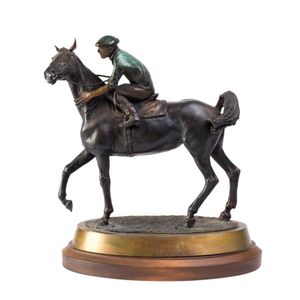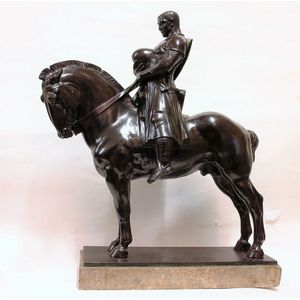Pair of Furietti Centaur Bronzes on Marble Bases
You must be a subscriber, and be logged in to view price and dealer details.
Subscribe Now to view actual auction price for this item
When you subscribe, you have the option of setting the currency in which to display prices to $Au, $US, $NZ or Stg.
- Carrara Marble - Carrara marble is a type of white or blue-grey marble quarried in the Carrara region of Tuscany, Italy. It is prized for its beauty, durability and the ease with which it can be worked. The marble has been used for thousands of years for sculptures and architectural details, and was particularly popular during the Renaissance period. Some of the most famous sculptures in the world, such as Michelangelo's David, were carved from Carrara marble. It is also widely used in the construction of buildings, floors, and countertops, both indoors and outdoors. This marble is known for its unique veining which gives it a distinctive look, and it's a popular choice for interior design, especially bathrooms and kitchens.
- Emblematic - Serving as a symbol.
- Bronze - An alloy of copper and tin, traditionally in the proportions of about 9 parts of copper to 1 part of tin.
The discovery of bronze in Western Asia in the 4th century enabled people to create metal objects which were superior to those previoulsy possible because of its strength and hardness, and it has been used throughout the world for weapons, coins, tools, statuary and other decorative items.
It is very fluid in a molten state, and its hardness, strength when set, and non-corrosive properties makes it most suitable for casting sculpture.
This item has been included into following indexes:
Visually similar items

Brian Engris (born 1943), A 'metal bronze' model of horse and jockey, signed to base 'Engris 1988', 5/6 made, 44 cm high

Gustav Adolf Daumiller, Praying Knight on Horseback' large bronze sculpture c.1923, the horse with short tail and short mane in tight posture, head slightly inclined and turned to the left side, Knight with chain armour, chain shoes and sword, holding a he

An Indian bronze dancing figure on a round lotus base, probably 19th century. Provenance: A Private Sydney Collection

A 19th century bronze censer on caryatid feet, the cover with a cupid
